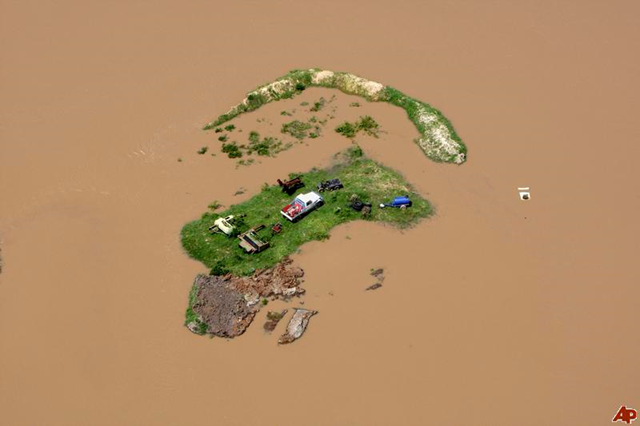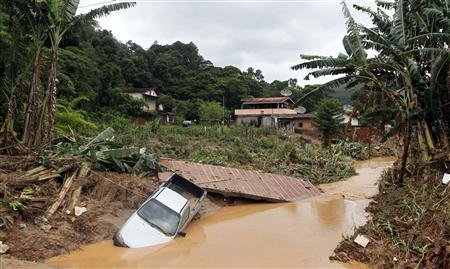La Niña fury causing floods around the world: Australia, South Africa, Brazil, Sri Lanka, and the Philippines
AlJazeera English
January 13, 2011 Floods and mudslides in Brazil have killed more than 330 people, with more feared dead after three towns just north of Rio De Janeiro were hit on Wednesday. A month’s worth of rain fell in one day in parts of Rio De Janeiro state and roads and bridges were swept away by the mud. Rescue efforts will begin again later on Thursday as the Brazilian President tours the area by helicopter. Rescuers expect to find more bodies as they reach towns they cannot yet access, but more expected rain threatens to further aggravate the situation. Al Jazeera’s Gabriel Elizondo reports from Teresopolis, one of Brazil’s worst affected areas.
RIO DE JANEIRO (Reuters) – Floods and landslides devastated towns in a mountainous area near Rio de Janeiro, killing dozens of people and bringing the death toll on Wednesday from days of heavy rain in southern Brazil to at least 83. At least 54 people were killed in Teresopolis about 100 km north of Rio, the town’s mayor said, after hillsides and riverbanks buckled under the equivalent of a month’s rainfall in 24 hours. At least 16 other people were killed in two other towns in the region, officials with the government’s Civil Defence agency said. The rains sweeping southeastern Brazil also killed 13 people in Sao Paulo state on Tuesday and snarled transport in the country’s financial capital. The death toll was expected to rise, with about 50 people believed missing just in Teresopolis, mayor Jorge Mario told Globo television. “There are 48 dead, and that number will rise because rescue teams are still arriving in the areas that have been worst affected,” he said, adding that about 1,000 people had been left homeless. “It’s the biggest catastrophe in the history of the town.” Thousands of people in the picturesque area, known as the Serrana region, were isolated by the flood waters and cut off from power and telephone contact. Meanwhile, heavy monsoon rains on Wednesday kept Sri Lanka’s president from visiting areas inundated by flooding that has killed 18 people, forced 196,000 from their homes across a third of the nation, and threatened food supply. Nearly a fifth of Sri Lanka’s rice paddies are either destroyed or under standing water that could wipe out the crop, the Agriculture Ministry said, raising concerns over supply shocks and higher food inflation for Sri Lanka’s staple food. Greater-than-normal monsoon rains since early January have hit the Indian Ocean island in the Northern, Eastern, Central and North Central provinces, building up to cause mudslides, swamp roads and burst hundreds of dams and reservoirs. Sri Lanka’s Disaster Management Centre said that at least 18 people had been killed across the country, with a landslide in the hilly Kandy area killing at least seven people. Meanwhile, at least 30 people may have been killed and about 1,000 homes damaged by floods in South Africa in the past week, a government estimate showed on Wednesday. There were no estimates available yet for the amount of damage caused in the major African food producer and global mining power, the ministry of cooperative governance said in a statement.
Floods, landslides kill 131 worldwide 
Floods are bringing death in other countries as well as Australia. At least 30 people may have been killed and about a thousand homes damaged by floods in South Africa in the past week. Heavy rains have hit Johannesburg and Pretoria as well as provinces in the northeast and eastern parts of the country. In Brazil, floods and landslides have devastated mountain towns near Rio de Janeiro, killing 147 people. The death toll from heavy rains this week is at least 160.
Officials say at least 120 people have been killed in Teresopolis, about 100km north of Rio, after the equivalent of a month’s rainfall in 24 hours. Rain in southeastern Brazil also killed 13 people in Sao Paulo state and caused traffic congestion in the country’s financial capital. In Sri Lanka, heavy monsoon rains have caused severe flooding, displacing nearly 200,000 people. At least 80 are known to have died. Camps set up for flood victims have themselves been flooded. About a million people have been affected.
Floods in South Africa, Brazil and Sri Lanka
13 January 2011 (BBC) – An image has emerged from Sri Lanka of a dead elephant calf stuck high in a tree after getting caught up in the country’s fast-flowing floods.
The animal was found near the Kaloya river in northern Sri Lanka, which rose 18ft (5.5m) above its normal height. Local villagers alerted photographer Kanchana Kumara Ariyadasa, who took the picture on Thursday. He believes the photo will be a defining image of the country’s recent heavy flooding. “I have been working as a journalist for the last 10 years but this is likely to be one of the strangest photos I will ever take in my career,” Mr Ariyadasa told the BBC. “The animal is still stuck in the tree as we speak while wildlife officials work out the best way to get it down to conduct a post-mortem examination.” Thousands of animals – including elephants, snakes, water buffaloes and livestock – are thought to have perished in the floods. More than 30,000 army, navy, police and air force personnel are currently battling to provide urgent aid to people hit by the disaster. At least 23 people have died and more than a million have been affected by the flooding, which the government says has displaced more than 325,000 people.
Flood-hit Sri Lankan elephant calf found dead in tree 
By Manny Mogato; Editing by John Mair
Thu Jan 13, 2011 1:29am EST MANILA (Reuters) – Sustained heavy rain and floods in the central and southern Philippines have killed 42 people and damaged crops and infrastructure worth more than 1 billion pesos ($23 million), disaster officials said on Thursday. Floods and landslides caused by more than two weeks of heavy rains in late December and January have displaced nearly 400,000 people, Benito Ramos, head of the government’s disaster agency, told reporters on Thursday. Major rice and corn production areas in the north and western part of the country have been spared. “Our soldiers are using helicopters to deliver relief goods and survey areas for clearing and rehabilitation,” Ramos said, appealing for food, water, medicines and warm clothes. Most of the dead either drowned or were buried by mudslides, Ramos said. Five people are still missing, including three fisherman. About a third of the country’s 80 provinces had been affected by the rains, which have destroyed roads and bridges, small rice and corn farms and houses made of light materials, Ramos said. On Friday, President Benigno Aquino will visit several flood-hit provinces in the central Bicol, eastern Visayas and Mindanao regions to assess the damage and determine how much money is needed for rebuilding.
Philippine floods, landslides kill 42

